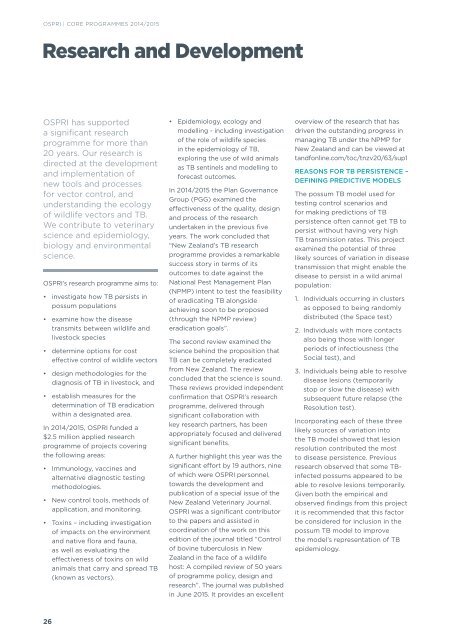Create successful ePaper yourself
Turn your PDF publications into a flip-book with our unique Google optimized e-Paper software.
OSPRI | CORE PROGRAMMES <strong>2014</strong>/<strong>2015</strong><br />
Research and Development<br />
OSPRI has supported<br />
a significant research<br />
programme for more than<br />
20 years. Our research is<br />
directed at the development<br />
and implementation of<br />
new tools and processes<br />
for vector control, and<br />
understanding the ecology<br />
of wildlife vectors and TB.<br />
We contribute to veterinary<br />
science and epidemiology,<br />
biology and environmental<br />
science.<br />
OSPRI’s research programme aims to:<br />
• investigate how TB persists in<br />
possum populations<br />
• examine how the disease<br />
transmits between wildlife and<br />
livestock species<br />
• determine options for cost<br />
effective control of wildlife vectors<br />
• design methodologies for the<br />
diagnosis of TB in livestock, and<br />
• establish measures for the<br />
determination of TB eradication<br />
within a designated area.<br />
In <strong>2014</strong>/<strong>2015</strong>, OSPRI funded a<br />
$2.5 million applied research<br />
programme of projects covering<br />
the following areas:<br />
• Immunology, vaccines and<br />
alternative diagnostic testing<br />
methodologies.<br />
• New control tools, methods of<br />
application, and monitoring.<br />
• Toxins – including investigation<br />
of impacts on the environment<br />
and native flora and fauna,<br />
as well as evaluating the<br />
effectiveness of toxins on wild<br />
animals that carry and spread TB<br />
(known as vectors).<br />
• Epidemiology, ecology and<br />
modelling - including investigation<br />
of the role of wildlife species<br />
in the epidemiology of TB,<br />
exploring the use of wild animals<br />
as TB sentinels and modelling to<br />
forecast outcomes.<br />
In <strong>2014</strong>/<strong>2015</strong> the Plan Governance<br />
Group (PGG) examined the<br />
effectiveness of the quality, design<br />
and process of the research<br />
undertaken in the previous five<br />
years. The work concluded that<br />
“New Zealand’s TB research<br />
programme provides a remarkable<br />
success story in terms of its<br />
outcomes to date against the<br />
National Pest Management Plan<br />
(NPMP) intent to test the feasibility<br />
of eradicating TB alongside<br />
achieving soon to be proposed<br />
(through the NPMP review)<br />
eradication goals”.<br />
The second review examined the<br />
science behind the proposition that<br />
TB can be completely eradicated<br />
from New Zealand. The review<br />
concluded that the science is sound.<br />
These reviews provided independent<br />
confirmation that OSPRI’s research<br />
programme, delivered through<br />
significant collaboration with<br />
key research partners, has been<br />
appropriately focused and delivered<br />
significant benefits.<br />
A further highlight this year was the<br />
significant effort by 19 authors, nine<br />
of which were OSPRI personnel,<br />
towards the development and<br />
publication of a special issue of the<br />
New Zealand Veterinary Journal.<br />
OSPRI was a significant contributor<br />
to the papers and assisted in<br />
coordination of the work on this<br />
edition of the journal titled “Control<br />
of bovine tuberculosis in New<br />
Zealand in the face of a wildlife<br />
host: A compiled review of 50 years<br />
of programme policy, design and<br />
research”. The journal was published<br />
in June <strong>2015</strong>. It provides an excellent<br />
overview of the research that has<br />
driven the outstanding progress in<br />
managing TB under the NPMP for<br />
New Zealand and can be viewed at<br />
tandfonline.com/toc/tnzv20/63/sup1<br />
REASONS FOR TB PERSISTENCE –<br />
DEFINING PREDICTIVE MODELS<br />
The possum TB model used for<br />
testing control scenarios and<br />
for making predictions of TB<br />
persistence often cannot get TB to<br />
persist without having very high<br />
TB transmission rates. This project<br />
examined the potential of three<br />
likely sources of variation in disease<br />
transmission that might enable the<br />
disease to persist in a wild animal<br />
population:<br />
1. Individuals occurring in clusters<br />
as opposed to being randomly<br />
distributed (the Space test)<br />
2. Individuals with more contacts<br />
also being those with longer<br />
periods of infectiousness (the<br />
Social test), and<br />
3. Individuals being able to resolve<br />
disease lesions (temporarily<br />
stop or slow the disease) with<br />
subsequent future relapse (the<br />
Resolution test).<br />
Incorporating each of these three<br />
likely sources of variation into<br />
the TB model showed that lesion<br />
resolution contributed the most<br />
to disease persistence. Previous<br />
research observed that some TBinfected<br />
possums appeared to be<br />
able to resolve lesions temporarily.<br />
Given both the empirical and<br />
observed findings from this project<br />
it is recommended that this factor<br />
be considered for inclusion in the<br />
possum TB model to improve<br />
the model’s representation of TB<br />
epidemiology.<br />
26


